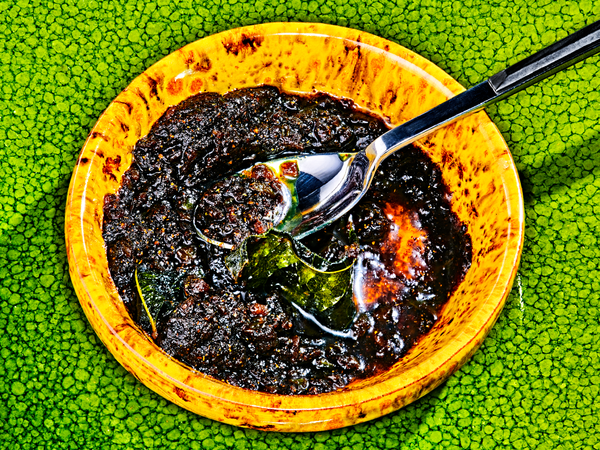Paul Carmichael, the chef at Momofuku Seiobo in Sydney, grew up in St. James Parish, Barbados, on the west side of the island. His mother woke early on Sundays to prepare the lunch they’d eat after church. One of his favorites, he told me recently: lamb, the meat folded into a cast-iron pot, marinated in burned sugar and the ruddy yellow curry powder that is common across the Caribbean, as British as it is Indian. “She’d cook it low, low, low,” he said, in not much more than the meat’s own fat, more of a pan-roast than a stew, then take the family to services and serve the meat afterward, melting and hot, with macaroni pie, rice and peas, coleslaw, potato salad. The meal delivered an hour of pleasure in a day not easy on children. At Full Gospel Assembly, where Carmichael’s parents still worship, an evening liturgy follows the morning one.
Another Carmichael childhood memory: the curried chow mein his brother Pedro cooked, built on a base of deeply caramelized onions run through with cumin, garlic and more of that curry powder, the noodles tossed with stir-fried chicken and vegetables, salty with soy sauce. The Carmichaels are a family of chefs. Pedro now teaches cooking at West Herts College, northwest of London. His chow mein, Paul said, was “delicious,” inserting a celebratory, profane adverb in front of the adjective.
Curry powder, rice, soy sauce, the savory zing of sugar cooked black: These are among the tastes of Caribbean cooking, ingredients and techniques brought to the islands by slavery, colonialism, indentured servitude. They have melded over centuries into a cuisine unto itself: kind of African, Arawak, British, Chinese, French, Spanish, Indian; kind of not. Carmichael laughed when we were talking about it, trying to figure it out — how curry powder moved through the Commonwealth nations of Britain, from East Indies to West; how well mango chutney goes with soy sauce and fried rice; how there are clear African roots in Bajan cou-cou; and how, gloriously, food can bring comfort to the afflicted, can stay cultures that others would erase. “Caribbean food is fusion cooking where the fusion actually happened over time in real life,” he said. “Everyone wants to find likeness and common ground in it, instead of just accepting it for what it is.” What it is, he said, “is tasty.”
We talked after a light dinner I had at Seiobo, just off a late flight from Melbourne, that perfectly illustrated his point of view. Seiobo is part of David Chang’s growing empire of Momofuku restaurants that are generally somehow Asian in cuisine or cooking style. But Carmichael, since his arrival in Australia in 2015, has steered Seiobo in a very different direction. My snack-menu dinner that night might have been served at a restaurant in Trinidad or Guyana: deep-fried paddles of Australian crab, with slices of lime and a pile of curried rice. The crab was lumpy and sweet, pure in flavor below its crust, but it was the rice that shocked and demanded conversation. It was built on a base of long-cooked curry paste: a beautiful dark golden hue, fragrant with cumin, cardamom, coriander, a big hit of ginger and garlic, with minced habanero for heat and a salty punch of soy and oyster sauces hovering over it all. It seemed to tell the story of Caribbean food in just a couple of bites.

Curry paste.CreditBobby Doherty for The New York Times. Food stylist: Maggie Ruggiero. Prop stylist: Rebecca Bartoshesky.
The recipe makes a lot of curry paste. Use as much as you need to season the rice, which is an ideal side dish for fried fish or chicken, for soft-shell crabs, for paillards of pork, for stew. However much you require, there’ll be some left over, even if you season your rice aggressively. That’s a great opportunity. The paste keeps well in the refrigerator. Later, you can use it to spice up instant ramen or to enliven ground meat for a Caribbean-ish version of sloppy joes; to make a kind of curried stew of vegetables or beef; or to rub all over a leg of lamb.
“It’s weird, man,” Carmichael said. “People in Sydney find comfort in the way that we cook here, and sometimes I think it’s because they taste these flavors that are Asian, and they think it’s Asian food. But it’s more complicated than that. I’m making this food from a cuisine that’s super diverse and really young, that doesn’t have thousands of years of history behind it, only hundreds.” It is food that requires both explanation and none at all.
Recipe: Paul Carmichael’s Curried Rice





